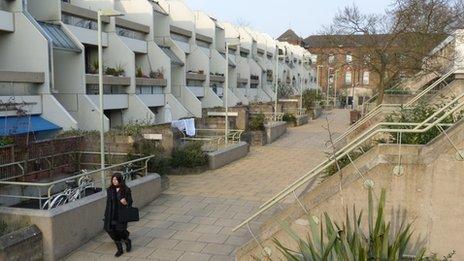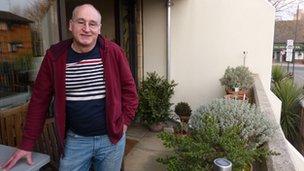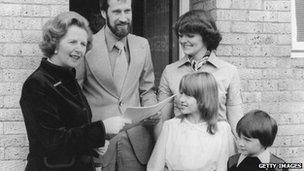Right-to-buy: Margaret Thatcher's controversial gift
- Published

The north London estate where right-to-buy has polarised opinions
The Whittington estate in north London is an extraordinary monument to the far-sighted council dreamers of the 1970s, to its talented Hungarian architect, and to Margaret Thatcher's right-to-buy policy.
The estate, which tumbles down a hillside below Highgate, opened in 1979, the year she came to power.
Every flat here has its own south-facing balcony or courtyard. There is an abundance of greenery, designed as a visual continuation of the wild space of Highgate cemetery, which borders the estate.
Karl Marx, buried among the ivy and brambles, would surely have applauded a publicly funded project that upgraded the lives of its working-class inhabitants.
But the thought of Mrs Thatcher spreading her philosophy of home ownership here may well have felt as if the lady herself was walking across his grave.
New owners
On this estate you will meet musicians, architects, and solicitors - alongside what in Mrs Thatcher's time were known as blue-collar workers: cleaners, hospital porters and bus drivers.
Of the 300 flats on the estate, two-thirds are occupied by council tenants. The rest are privately owned.
People like John Holland, who works as a security guard, bought his house from the council thirty years ago. That was shortly after Mrs Thatcher's Housing Act was passed in 1980, enabling tenants to buy their homes at a large discount.
At the time he and his sister paid £39,000 for their five-bedroom property, even though it was valued at around £70,000.
Today it is worth around £600,000.
Unsurprisingly, right-to-buy made him a happy man indeed.
"If it weren't for Mrs Thatcher's policy, we couldn't have afforded to buy," he says.
"There's no way we'd be property owners now if it wasn't for her. It was perfect, absolutely perfect."
'We are in a mess'
Other long-term residents of the estate have very different views. One man, who did not want to be named, said most people could not afford to buy at the time. Others who did manage to purchase had subsequently struggled.

Many, like Fabian Watkinson, are second-generation owners
"A lot of people who bought couldn't afford the repayments, because the economy went down under Mrs Thatcher," he says.
"Also the scheme meant they stopped building enough social housing."
Linda Treherne, a resident of the estate since it was built, is also bitter about the policy.
Under the rules, councils were prevented from reinvesting most of the proceeds of council house sales in new homes. After 1990, most local authorities were only allowed to spend 25% of such receipts on building houses.
"It took control away from the council's housing departments. Because of right-to-buy, we are in a mess," she complains.
She points out that some people on the estate bought two properties, and now rent them out.
"It really rankles me that people made such a profit," she says.

The Whittington estate has plenty of green space, making flats desirable
Social Mix
Some residents are second-generation owners, having bought their homes from the original council tenants.
Architect Alex Thomas paid £250,000 for his flat three years ago. The original tenant had bought it for just £30,000 in 2000.

The King family in Milton Keynes were among the first to receive the deeds to their council house
"He bought a yacht, I expect," says Thomas.
Fabian Watkinson, a musician, is also a second-generation owner. The previous owners sold it to him on the very first day they were allowed to, three years after they bought it from the council.
He is not exactly full of praise for Margaret Thatcher, but admits he is lucky to have it.
"I have to say I'm grateful for the right-to-buy. I'm very happy," he says.
But he believes the real legacy of the policy is in the nature of the mixed communities it created.
Here on the Whittington estate, professionals live right alongside manual workers; black and white live on the same streets.
"Right-to-buy has created a social mix," he says.
"Overall I think it worked very well. It has created a great sense of community. I know my neighbours."
Architect Alex Thomas agrees.
"The people who own flats take a pride in the place, and often get involved in community groups. So the policy had positive benefits."
Lying in his shady grave next door, Marx would never have agreed.
For this was a policy that attempted to cut across all class lines, and fulfil the very capitalist aspirations of acquiring a home and putting money in the bank.
But with two million Britons having taken up Margaret Thatcher's offer since 1980, even he would have to recognise its enduring appeal.
- Published8 April 2013
- Published26 February 2013
- Published16 November 2012